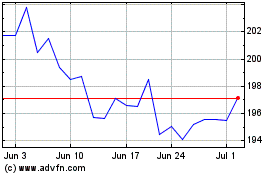Multiple Buyers, Not One, Influenced Most Active E-Mini Move of 2016
December 23 2016 - 3:37PM
Dow Jones News
By Alexander Osipovich
A sharp move in stock-market futures that fueled the Dec. 7
buying in U.S. equities likely reflected trading by multiple
buyers, said a market-data firm that shared its analysis with The
Wall Street Journal, a shift from its prior conclusion -- published
by the Journal -- that a single buyer was behind the move.
The firm, MayStreet LLC, said its initial analysis, which
characterized the event as a single $1.8 billion trade with one
unknown buyer behind it, was based on a misunderstanding of how CME
Group Inc. reports its raw data. Chicago-based CME is the exchange
where the contracts involved in the Dec. 7 event are traded.
MayStreet now says "there are multiple indicators that this was
not a single large order," according to a statement MayStreet
emailed to the Journal. Instead, it appears that more than 300
orders to buy futures went off simultaneously as the market reached
a key threshold, the firm said.
The shifting interpretation of the buying spree in E-mini
S&P 500 futures shows the difficulty of understanding complex
events in today's fast-moving electronic markets. The May 2010
"Flash Crash," in which regulators say the same contract played a
key role, was also the subject of conflicting early reports about
its causes and continues to be debated more than six years
later.
E-mini contracts are used by traders to bet on or hedge against
future moves in the S&P 500 stock-market index, and large moves
in the price of E-minis can have knock-on effects in the equity
market.
At 1:21 p.m. New York time on Dec. 7, about 16,000 of the
contracts were purchased at the same time, CME data shows.
MayStreet had previously said the 16,000 contracts were likely part
of one trade, which The Wall Street Journal reported on Dec. 12.
MayStreet's new analysis suggests the event was triggered by more
than 300 stop orders in the contract placed at levels between 2,225
and 2,228 points. Stop orders can be used to buy or sell futures
when the market reaches a certain level, according to CME
rules.
The E-mini purchases all had the same nanosecond timestamp and
ID number, indicating they were part of the same "event," the data
shows. That initially made it appear they were all part of one
large transaction, a conclusion that appeared in both MayStreet's
first analysis and the Journal's Dec. 12 article.
But a far more likely explanation was that the event was a
cascading series of stop orders executed together, MayStreet said
in an updated analysis shared with the Journal several days after
the article published.
The firm changed its view after being contacted by the Modern
Markets Initiative, a New York-based advocacy group for
high-frequency trading -- or HFT -- firms, which carried out its
own analysis of the Dec. 7 event and concluded it was caused by
multiple stop orders.
MayStreet said it stands by its conclusion that the move was the
largest event to occur at a single point in time in E-minis in
2016, with a total of $1.8 billion worth of the contracts snapped
up at once. "It doesn't take away the fact that it was an anomaly
and the biggest event of the year," MayStreet co-founder Michael
Lehr said.
It is not publicly known how many traders or which ones placed
the orders that caused the event. The identities of traders behind
orders are only available to CME. A spokeswoman for the exchange
said in an email that CME could not discuss "the specifics of any
particular trade(s)."
It is conceivable that one entity entered all the orders, but
MayStreet said that was extremely unlikely because of the sheer
volume of the purchasing and the fact that many of the orders were
for small sizes, as little as one contract each. That makes it more
likely that many traders placed the stop orders without knowing
that others were doing the same thing, MayStreet said.
It is also unclear why, if MayStreet's new analysis is correct,
so many stop orders were placed at the 2,225 level or just above
it. The level was an intraday high and reflected a historical
record in the S&P 500 at the time.
Some traders have speculated that the flurry of futures-buying
reflected hedging to cover losses on stock-market derivatives
trades as the market rose too high. Other observers have suggested
the buying was part of a "breakout" strategy, in which traders jump
into a market that has just moved sharply higher or lower after a
period of being range-bound.
As of Dec. 6, at least two analysts had their year-end targets
for the S&P 500 at 2,225, according to Birinyi Associates.
MayStreet's updated analysis matches the conclusions of MMI. MMI
undertook its own study of the Dec. 7 event to deter potential
suggestions that it was caused by a rogue algorithm or ultrafast
trading run amok.
MMI Chief Executive Bill Harts said the "craziest" aspect of the
event was that the apparent chain reaction of stop orders began
with a small trade, the purchase of just one E-mini contract at
2,225, according to CME's data. "That's an eye-popping amount of
trading in a very short time and occurred without any automated
trading or HFT," Mr. Harts said.
Write to Alexander Osipovich at
alexander.osipovich@dowjones.com
(END) Dow Jones Newswires
December 23, 2016 15:22 ET (20:22 GMT)
Copyright (c) 2016 Dow Jones & Company, Inc.
CME (NASDAQ:CME)
Historical Stock Chart
From Mar 2024 to Apr 2024

CME (NASDAQ:CME)
Historical Stock Chart
From Apr 2023 to Apr 2024
